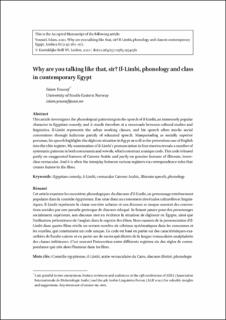| dc.contributor.author | Youssef, Islam | |
| dc.date.accessioned | 2022-05-27T11:50:43Z | |
| dc.date.available | 2022-05-27T11:50:43Z | |
| dc.date.created | 2020-04-22T17:33:27Z | |
| dc.date.issued | 2020 | |
| dc.identifier.citation | Youssef, I. (2020). Why Are You Talking Like That, Sir? Il-Limbi, Phonology and Class in Contemporary Egypt. Arabica, 67(2-3), 260-277. | en_US |
| dc.identifier.issn | 0570-5398 | |
| dc.identifier.uri | https://hdl.handle.net/11250/2996461 | |
| dc.description.abstract | This article investigates the phonological patternings in the speech of il-Limbi, an immensely popular character in Egyptian comedy; and it stands therefore at a crossroads between cultural studies and linguistics. Il-Limbi represents the urban working classes, and his speech often mocks social conventions through ludicrous parody of educated speech. Masquerading as socially superior personas, his speech highlights the diglossic situation in Egypt as well as the pretentious use of English into the elite register. My examination of il-Limbi’s pronunciation in four movies reveals a number of systematic patterns in both consonants and vowels, which construct a unique code. This code is based partly on exaggerated features of Cairene Arabic and partly on genuine features of illiterate, lower-class vernacular. And it is often the interplay between various registers via correspondence rules that creates humor in the films. | en_US |
| dc.language.iso | eng | en_US |
| dc.title | Why are you talking like that, sir? Il-Limbi, phonology and class in contemporary Egypt | en_US |
| dc.type | Peer reviewed | en_US |
| dc.type | Journal article | en_US |
| dc.description.version | acceptedVersion | en_US |
| dc.rights.holder | © Koninklijke Brill NV, Leiden, 2020. | en_US |
| dc.source.pagenumber | 260-277 | en_US |
| dc.source.volume | 67 | en_US |
| dc.source.journal | Arabica | en_US |
| dc.source.issue | 2-3 | en_US |
| dc.identifier.doi | https://doi.org/10.1163/15700585-12341561 | |
| dc.identifier.cristin | 1807558 | |
| cristin.ispublished | true | |
| cristin.fulltext | postprint | |
| cristin.fulltext | postprint | |
| cristin.qualitycode | 2 | |
